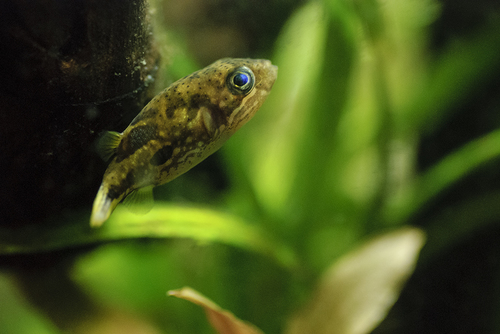
Dwarf Pufferfish
The Bluefin Tuna (Thunnus) is a group of large, powerful, and highly migratory fish prized for their speed, size, and culinary value. These apex predators play a crucial role in the marine ecosystem. Known for their distinctive metallic blue coloration and streamlined bodies, they are among the most impressive fish in the ocean.
4 5 years
Lifespan
2.5 - 3.5 cm
Length
Vulnerable
Conservation Status
N/A km/h
Swimming speed
Carnivorous, Insectivorous
Diet
Local Migration
Migration
Appearance Overview
The Bluefin Tuna is renowned for its large, streamlined body, built for speed and endurance in the water.
Color
Dark metallic blue on top with a silvery underside, allowing for camouflage in the open ocean.
Fins
Two dorsal fins, with the second being taller than the first; small, yellow finlets run down from the second dorsal and anal fins to the tail.
Body Shape
Torpedo-shaped, designed for efficient swimming.
Length
Up to 13 feet (4 meters), though commonly around 6.5 feet (2 meters).
Weight
Up to 2,000 lbs (907 kg), but typically around 550 lbs (250 kg).
Diet
Carnivorous, feeding on a variety of fish, squid, eels, and crustaceans.
Feeding Behavior
Highly active predators, Bluefin Tuna use their speed and agility to hunt. They often feed in coordinated groups, herding prey for efficient capture.
Social Behavior
Known to form schools, sometimes segregated by size. They are highly migratory, traveling vast distances across oceans.
Commercial Relevance
Extremely high value, particularly in the sushi and sashimi markets, where its fatty flesh is considered a delicacy.
Conservation measures
Measures include strict fishing quotas, international agreements to limit catches, and efforts to monitor and protect spawning grounds.
Status
Varies by species; Atlantic Bluefin are Endangered, Pacific Bluefin are Vulnerable, and Southern Bluefin are Critically Endangered.
Threats
Primarily threatened by overfishing due to high demand. Other threats include bycatch in fishing gear and habitat degradation.
Habitat Distribution
Depth Range
Typically found from the surface to depths of 1,640 feet (500 meters), but can dive deeper.
Geographic Range
Found in the Atlantic, Pacific, and Indian Oceans. Specific species have distinct ranges within these oceans.
Preferred Environment
Prefers temperate and subtropical waters; often found in open ocean environments but also comes closer to shore.
Reproduction and Life Cycle
Breeding Habits
Spawns in specific areas, such as the Mediterranean Sea and the Gulf of Mexico for Atlantic Bluefin, with spawning occurring in warm waters.
Development Stages
Eggs hatch into larvae, which develop rapidly in plankton-rich waters. Juveniles grow quickly, eventually reaching impressive sizes as adults.
Fecundity
Highly fecund; a single female can produce up to 30 million eggs per spawning season, though survival rates of eggs and larvae are low.
Maturity Age
Reaches sexual maturity between 4-8 years, depending on the species and environmental factors.
Faqs about Dwarf Pufferfish
How fast can Bluefin Tuna swim?
Bluefin Tuna are among the fastest fish in the ocean, capable of swimming at speeds up to 43 mph (70 km/h) in short bursts.
What is the lifespan of a Bluefin Tuna?
Bluefin Tuna can live up to 40 years, though this varies by species and environmental conditions.
Do Bluefin Tuna migrate?
Yes, they undertake extensive migrations across oceans for feeding and spawning, often traveling thousands of miles.
How does being warm-blooded help Bluefin Tuna?
Their warm-blooded nature allows them to maintain a higher body temperature than the surrounding water, aiding in muscle efficiency and speed.
Why are Bluefin Tuna populations declining?
Overfishing is the primary threat, driven by the high demand for their meat in the sushi and sashimi markets.
What is the largest Bluefin Tuna ever recorded?
The largest Bluefin Tuna ever recorded was caught off Nova Scotia, Canada, and weighed 1,496 lbs (679 kg).
Copyright @ Nature Style Limited. All Rights Reserved.
 English
English